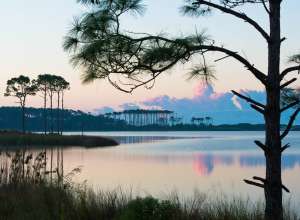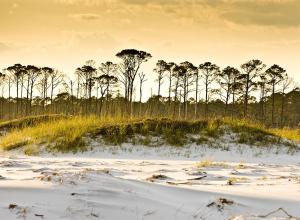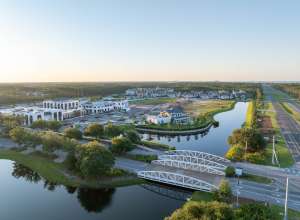Story
Reflecting on Our Rare Coastal Dune Lakes
November 14, 2013 by SoWal Guest

This year’s excessive rain opens our eyes to the impact Mother Nature has on living creatures, both human and non-human. Human behavior is directly affected by the amount of sunshine we receive daily, not to mention the fresh air and exercise, all critical to our health and happiness.
We wait for the sun to pop through the clouds so we can grab a boat or a board and head for the water. Our bodies in motion don’t know what to do with too much indoor time, especially here in paradise.
The rare coastal dune lakes are also impacted tremendously by the rain, as are the many creatures that live in and around them. I notice how different the lakes appear now, compared to early spring, and see a visible difference caused by the record-breaking rainfall, storm frequency, and winds.
Visitors come from around the world to experience all that Walton County offers: the unparalleled, 26 miles of sugar-white beaches, unspoiled beauty of the land, and numerous green communities. But the rare coastal dune lakes, located in only a few places on earth, are our true geological treasures. As I began the research for my book, Rare Coastal Dune Lakes: Biodiversity and a Sense of Home, the absence of a definitive list of global dune lake locations became apparent. Most sources say that, other than Walton County, you can only find coastal dune lakes in New Zealand, Madagascar, Australia, and maybe the Northwest US. What’s important to note is that here in South Walton, we are blessed with 15 of them!
Our dune lakes are so special in fact, that according to the Florida Natural Areas Inventory (FNAI) in 2010, the coastal dune lakes are considered globally imperiled due to rarity, and critically imperiled in the state of Florida because of extreme rarity.
Coastal Dune Lakes: What Are They? Walton County defines coastal dune lakes as shallow bodies of water located within two miles of the coast that occasionally intermingle with the Gulf. The lakes are composed of both fresh and saltwater from tributaries, groundwater seepage (from the uplands and the Gulf), rainfall, and coastal storm surges. Their levels rise and fall due to frequency, strength, and duration of storm activity, tidal flows and wind conditions. When water levels reach a critical point the lowest level of the beach opens up, creating a temporary outlet, or outfall, into the Gulf. Walton County named these 15 as coastal dune lakes: Fuller, Morris, Campbell, Stallworth, Allen, Oyster, Draper, Big Redfish, Little Redfish, Alligator, Western, Eastern, Deer, Camp Creek, and Lake Powell.
As you walk along the beach you’ll likely run into an outfall, where the water looks different than the emerald Gulf saltwater. Most locals know that the tea-colored water from a dune lake is not dirty. It is dark due to tannins from natural organic matter. Many folks who see an outfall for the first time are concerned that it is dirty or a problem for living creatures. Not so. These outfalls are a natural phenomenon, estuaries where a huge variety of shorebirds hang out, as both salt and freshwater fish swim back and forth from lake to Gulf.
Driving along Scenic Highway 30A, you will notice the spectacular dune lakes scattered along the coastline. Each lake has its own character and charm, from the pristine, private setting of Lake Fuller in Coffeen Nature Preserve; to the popular, sprawling Western Lake with its standup paddlers and natural beauty of Grayton Beach State Park; all the way to Lake Powell on the east end (half in Bay County).
The lakes waters are brackish (mixture of fresh and saltwater) with varying salinity and are constantly changing. This constant change in the water conditions creates a biologically diverse, natural habitat for plant and animal life. It’s no surprise that Walton County is considered one of the most bio-diverse spots in North America. It’s one of the many reasons we are drawn to this area. Its magnificent landscape, plant and animal life are subjects for painters, photographers, hikers, and cyclists to enjoy year-round.
New Excitement With new interest and excitement surrounding the costal dune lakes from the community, I’m delighted to be a contributing author on SoWal.com, bringing information and stories about our rare geological treasures along the Gulf coast. When I published my book in May, I had no idea of the excitement the topic would generate in people. The Coastal Dune Lakes Advisory Board, South Walton Tourist Development Council, and Board of County Commissioners are showing a renewed interest in the lakes that is well deserved. Dr. Sarah Schindele of the Choctawhatchee Basin Alliance wrote the eloquent Foreward to my book and she has been instrumental in getting the word out about the lakes and the biodiversity of their ecosystems.
Stay tuned here on SoWal.com to read more about how very special the coastal dune lakes are. I’ll keep readers posted on events, updates, and how to make a difference in preserving the natural beauty and rarity of these waters.

Ginger Jackson Sinton is the author of Rare Coastal Dune Lakes: Biodiversity and a Sense of Home, a full-color 112-page softbound coffee table photo book about the lakes and the Scenic 30A area. She is owner of GS Designs, a graphic design/marketing company, mother, nature lover, and part-time South Walton resident.
















